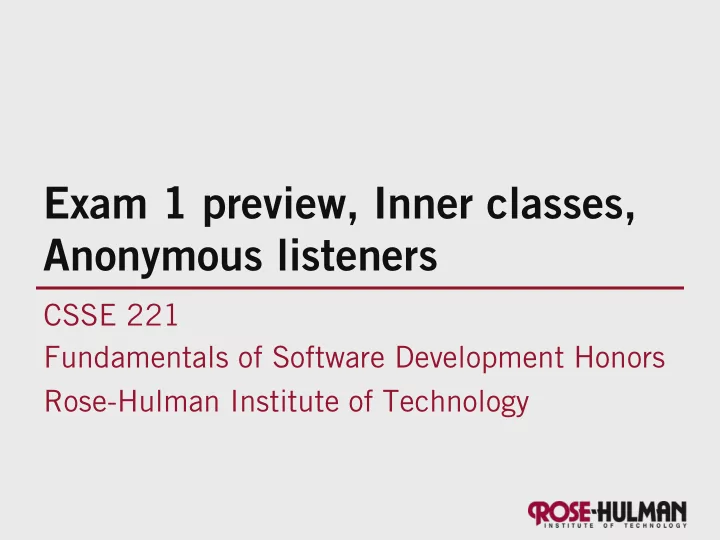

Exam 1 preview, Inner classes, Anonymous listeners CSSE 221 Fundamentals of Software Development Honors Rose-Hulman Institute of Technology
Announcements • Questions on Fifteen or GUIs? • Be prepared to show me or a TA your Fifteen UML and User stories before the end of class today.
This week: Fifteen assignment • Last class: – Fifteen speci fi cation – GUIs using Java’s Swing library – Intro to UML as a design tool • Wednesday: – EventListeners: responding to user input – Shape classes • Today: – Exam 1 preview – Anonymous listeners
Exam 1 Sample posted on Moodle
Exam 1 • Chapters from Text: – 1 to 12 (includes Swing Demo) • Paper part required resources: – 8 ½ ” by 11” sheet of hand written notes – Closed computer or electronic devices – Closed book • Computer Part required resources: – Open book, notes, computer – Limited network acccess
Exam 1 • Covers through start of week 3 (Swing intro) • Next Wednesday and Friday (~ 2 to 3 hours) • Sample exam 1 is posted on Moodle • Short written portion: closed-book • Programming portion: open-book, 221 website (including summaries and Piazza), Eclipse workspace – You may reference any course materials or any code that you did solo or with a partner
Exam 1 details • Paper part is worth about 50% to 60% • Computer part is worth about 40% to 50% • Spend about 40 to 50 minutes on paper part • Spend about 1 hour on computer part • Will give some extra time if needed
More Exam 1 Details • Venue: – Section 1: Olin Hall, room 257/231 – Section 2: Olin Hall, room 167 • What questions do you have?
Handling Events: Recap • Many kinds of events: – Mouse pressed, mouse released, mouse moved, mouse clicked, button clicked, key pressed, menu item selected, … • We create event listener objects – that implement the right interface – that handle the event as we wish • We register our listener with an event source – Sources: buttons, menu items, graphics area, …
Using Inner Classes • Classes can be de fi ned inside other classes or methods • Used for “smallish” helper classes • Example: Ellipse2D.Double Outer class Inner class • Often used for ActionListener s…
Anonymous Classes • Sometimes very small helper classes are only used once – This is a job for an anonymous class! • Anonymous à no name • A special case of inner classes • Used for the simplest ActionListener s…
Inner Classes and Scope • Inner classes can access any variables in surrounding scope • Caveats: – Local variables must be final – Can only use instance fi elds of surrounding scope if we’re inside an instance method • Example: – Prompt user for what porridge tastes like
Summary on inner classes • You can de fi ne a class inside another class – This is called a nested class – It has access to the outer class’ fi elds and methods – Useful if the inside class is a “helper class” of interest only to the outside class • You can de fi ne a class and construct an instance of it inside a method – This is called a local inner class – Useful if the class is small and the object refers to variables in the outside class • You can even make the inside class anonymous. – This is called an anonymous inner class This nomenclature is not universal. See http://blogs.oracle.com/darcy/entry/nested_inner_member_and_top for more than you could possibly want to know about this subject
“Fifteen” Arrays (especially 2D) Creating GUIs using Swing Responding to mouse clicks
Show us your Fifteen Design • Show us your UML • Show us your user stories
Recommend
More recommend